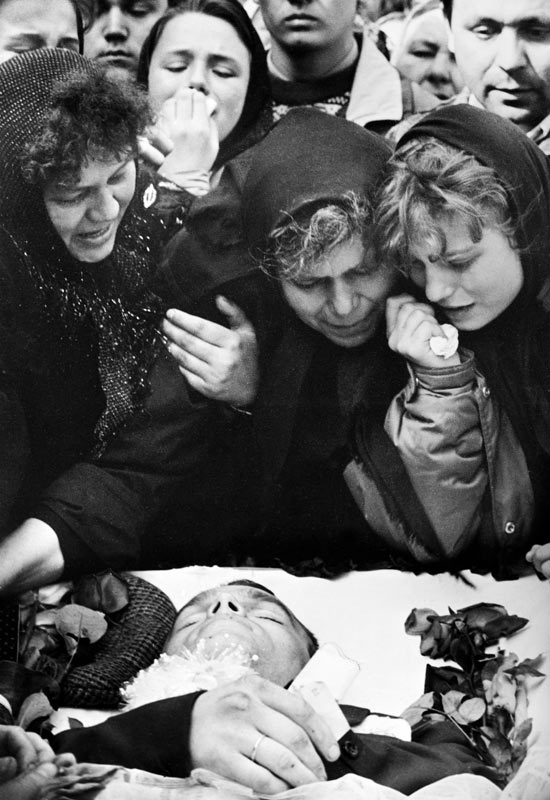-->Transnistria-Moldova Territorial Dispute (ICE)
1. Abstract
Transnistria-Moldova Conflict: Territorial Dispute
 |
Transnistria is referred to in one of three
principal
ways:
Stinga Nistrului (Left Bank of the Nistru) (by official
Moldovan sources)
Pridnestrovskaja Moldavskaja Respublika ((PMR) (by
Transnistrian official sources)
Moldovan Republic of Transnistria (MRT) (by European Court
of
Human Rights) |
Territorial disputes are often related to the possession of natural
resources
such as rivers, fertile farmland, mineral or oil resources. However, these
disputes can also be driven by culture, religion and ethnic nationalism. The
Transnistria-Moldova conflict has its roots in geopolitical, economical and
environmental motives. Transnistria is a self-declared state; it is
internationally recognized as being part of Moldova, but claims independence
and
maintains some sovereignty with the assistance of Russia. The region has
been de
facto independent since 1991, when it made a unilateral declaration of
independence from Moldova and successfully defeated Moldovan forces, with
Russian assistance. While a ceasefire has held ever since, the Council of
Europe
recognizes Transnistria as a "frozen conflict" region.
2. Description
In many cases territorial disputes result from vague and unclear language
in
a treaty that set up the original boundary. Moldova has a long history as a
border state between great powers, therefore Transnistria can make claims to
a
special political status on historical grounds [8]:
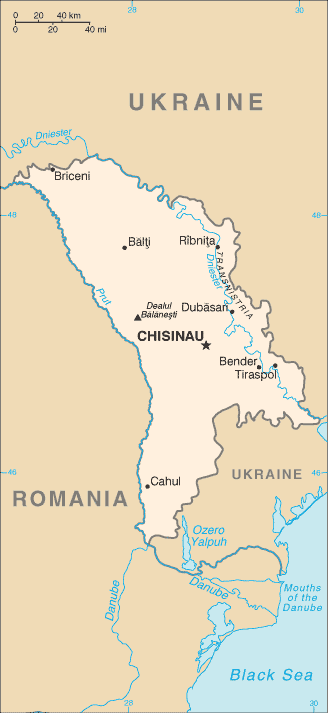 |
Middle Ages to the 20th Century
In the early Middle Ages the region was populated by Slavic tribes
of
Ulichs and Tivertsy as well as by Turkic nomads such as Pechenegs and
the
Polovtsi. A part of Kievan Rus' at times, and a formal part of the
Grand
Duchy of Lithuania in the 15th century, the area came under the
control of
the Ottoman Empire in 1504. It was eventually ceded to the Russian
Empire
in 1792. At that time, the population was sparse and mostly
Moldovan/Romanian and Ukrainian, but also included a nomadic Tatar
population. The end of the 18th century marked the Russian Empire's
colonization of the region, with the aim of defending what was at the
time
the Imperial Russian southwestern border, as a result of which large
migrations were encouraged into the region, including people of
Ukrainian,
Russian, and German nationalities.
Autonomous Republic
In 1918 the Directory of Ukraine proclaimed its sovereignty over
the
left bank of the Dniester. At that time, the population was 48%
Ukrainian,
30% Moldavian, 9% Russian, and 8.5% Jewish. One third of that region
(around Balta) belongs today to Ukraine. In 1922 the Ukrainian SSR was
created, and in 1924 the region became part of the Moldavian ASSR
within
the Ukrainian SSR.
The Moldavian SSR, which was set up by a decision of the Supreme
Soviet
of the USSR on the 2nd of August, 1940, was formed from a part of
Bessarabia taken from Romania on the 28th of June, following the
Molotov-Ribbentrop pact, where the majority of the population were
Romanian speakers, and a strip of land on the left bank of the
Dniester in
the Ukrainian SSR, Transnistria, which was transferred to it in 1940.
In
1941, after Axis Forces invaded Bessarabia in the course of the Second
World War, they advanced over the Dniester river. Romania annexed the
entire region between Dniester and Bug rivers, including the city of
Odessa. However, the Soviet Union regained the area in 1944 when the
Soviet Army advanced into the territory driving out the Axis forces.
Soviet Moldova
The Moldovian SSR became the subject of a systematic policy of
Russification, even more so than in Czarist times. Most industry that
was
built in the Moldavian SSR was concentrated in Transnistria, while the
rest of Moldova had a predominantly agricultural economy. The 14th
Soviet
army had been based there since 1956 and was kept there after the fall
of
the Soviet Union to safeguard what is probably the biggest weapons
stockpile and ammunition depot in Europe, which was set up in Soviet
times
for possible operations in the event of World War III.
|
The Secession
During the last years of the 1980s, the political landscape of the USSR
was
changing owing to Mikhail Gorbachev's policy of perestroika, which allowed
political liberalisation at the regional level. The incomplete
democratization
was preliminary for the nationalism to become the most dynamic political
force.
Some national minorities opposed these changes in the Moldovan political
class
of the republic, since during Soviet times, local politics had often been
dominated by non-Romanians, particularly by those of Russian origin. The
language laws -- introducing the Latin alphabet for written Moldovan --
presented a particularly volatile issue as a great proportion of the
non-Romanian population of the Moldavian SSR did not speak Moldovan. The
problem
of official languages in the Republic of Moldova has become an official
cause
for a conflict, being exaggerated and, perhaps, intentionally politicized.
On the 2nd of September, 1990 the Moldovan Republic of Transnistria was
proclaimed. On the 25th of August, 1991 the Supreme Council of the MRT
adopted
the declaration of independence of the MRT. On the 27th of August, 1991 the
Moldovan Parliament adopted the Declaration of Independence of the Republic
of
Moldova, whose territory included Transnistria. The Moldovan Parliament
asked
the Government of the USSR "to begin negotiations with the Moldovan
Government
in order to put an end to the illegal occupation of the Republic of Moldova
and
withdraw Soviet troops from Moldovan territory".
After Moldova became a member of the United Nations (March 2nd, 1992),
Moldovan President Mircea Snegur authorized concerted military action
against
rebel forces. The rebels, aided by contingents of Russian Cossacks and the
Russian 14th Army, consolidated their control over most of the disputed
area.
The presidents of Moldova and Russia signed an agreement in July of 1992
which
ended the conflict and established a "security zone" controlled by Russian,
Moldovan, and Transnistrian forces. In October of 1994, the Moldovan and
Russian
governments signed another agreement whereby the Russian government agreed
to
withdraw the 14th Army forces from Moldovan territory over a three-year
period.
The Russian State Duma, however, has not approved the agreement and Russian
forces remain in Transnistria. The presidents of Russia and Ukraine brokered
an
agreement in May of 1997 between the Moldovan and Transnistrian governments
which ended the civil war. Under the terms of the agreement, Transnistria
would
remain Moldovan territory unless Moldova decides to reunite with Romania. In
this situation, Transnistria is guaranteed the right to
self-determination.
To view chronology of important historical events and dates of Moldova
and
Transnistria please follow this link.
3. Conflict Duration: 1990-1992
Combat action: June 19th, 1992 to July 21st, 1992 when a cease-fire
agreement
was signed. However, Transnistria is considered to-date to be a "frozen
conflict" region.
4. Location:
Moldova is a landlocked country in Eastern Europe, located between Romania to the west and Ukraine to
the
east. Transnistria is a region within Moldova, located between the Dniester
River and the Ukrainian border which covers a territory of 500 square
kilometers
where most of the combat action took place. Geographic
coordinates: 47 00 N, 29 00 E
5. Actors
Local interests
Moldovan officials: the conflict is believed to be
driven by
foreign interests (particularly of Russia) over which Moldova has little or
no
influence. However, Jonathan Goodhand found in his field study that "the
interests vested in the status quo on both sides are stronger than those
wanting
change".
Transnistrian officials: two political camps emerged.
Separatists wish to maintain a "frozen conflict" status, while human rights,
and
free-press advocates hope for political reconciliation.
Local entrepreneurs: conflict is prolonged by the
economic
interests of officials on both sides in the illegal and informal trade,
bribes
at customs posts, and fees charged for licenses and export certificates,
made
possible by the situation. It is said that the annual volume of smuggling
represents the loss to Moldova of the equivalent of more than two annual
government budgets.[6]
General public: Mixed opinions-there are people who live
in
Transnistria and work in Moldova and vice versa. Others have relatives
living
both in Transnistria and Moldova. Many mayors in the north remain in contact
and
co-operate economically, based on pre-independence political and
administrative
ties. Links have been created and supported by third-party mediation
processes
and some economic co-operation occurs between local and regional officials
in
the two parts. [6]
External interests
The Transnistria talks follow a “5-plus-2” format, referring to the five
principal participants involved in the negotiations – Transnistria, the
Republic
of Moldova, Ukraine, the Russian Federation and the OSCE as mediators – plus
the
United States and the European Union as observers.
Russia: Russian policy under Vladimir Putin is not yet
clear, but Russian security interests will certainly continue to be present.
Russian involvement in this conflict is also fed by the Russian interest of
preventing Moldova from becoming too Western-oriented.
Ukraine: some view the Ukraine's new push for closer
ties
with European institutions (NATO and EU) as motivating an interest in being
perceived as helpful in resolving the conflict. It clearly has a stake in
preventing a new war on its border; for example, in 1992, it took in 72,000
refugees from Transnistria.[6]
Romania: One of the countries indirectly interested in
the
conflict is Romania whose main objective is to enter the EU in 2007. The
geographic position of Romania from a strategic point of view makes Romania
a
very interesting consideration in NATO and EU agreements of security. This
strong desire to be part of EU makes the Romanian government worried about
its
proximity to a conflict region. Another important consideration is the
security
pact with NATO and the compromise to guarantee peace in the area. [4]
Recently Romanian President Traian Basescuhas
also
underlined the necessity of launching a new European project-creating a
Black
Sea Euroregion. Therefore, Romania is interested in the unification of
Transnistria and Moldova and further European integration of Moldova.
Transnistria-Moldova relations involve two states and one nation, therefore
Traian Basescu compared current status of the conflict to the example of
Germany's reunification: "We have decided to support the Moldovan
Republic's
efforts to abide by democratic norms and contribute to the consolidation of
regional security. We believe the European Union should provide the Moldovan
Republic with an evolution similar to that for the Western Balkans."[25]
EU and Organization for Security and Cooperation in Europe:
EU is determined to keep peace in Europe (especially after the war
in
Yugoslavia) and also to control a number of illegal activities originating
in
Moldova and Transnistria (human, organ and weapon trafficking). EU
also
warned Transnistrian government to impose strict sanctions: one of them
being
the prohibition to all members of Tiraspol (capital of Transnistria)
government
to travel within EU territory. EU also has a strategic interest in
guaranteeing
safe borders to stimulate EU investment in the region. [4]
USA: USA is supporting the idea of a federal state of
Transnistria and Moldova because this would eliminate the double taxation
system
and would increase investment in the area. Another reason to support the
idea of
a federal model is to diminish the presence of Russian troops in the area
and
the threat of Russian control. Another point of interest for the US is
a
strategic one: ending the conflict creates a possibility of establishing
agreements to build military bases near the Russian border. However, at
present
time the US is not involved on either side of the
conflict. [4]
6. Type of Environmental Problem
SOURCE PROBLEMS OF
CONFLICT: DEFORESTATION [DEFOR]
The military conflict between Transnistria and Moldova had a tremendous
impact on the ecosystem of Moldova. The use of modern conventional armaments
and
thousands of refugees escaping the fighting through ecologically delicate
forests tremendously affected the forest system of Moldova.
Table 1: Moldova Forest Profile
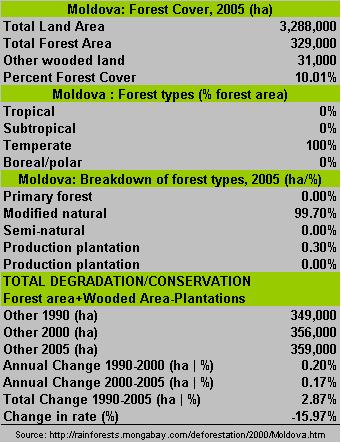
To view Moldova's profile on forests, grasslands and drylands please
refer to
the Earth Trends Country Profiles.
Moldovan forests suffer from different anthropogenic factors, the most
significant of them being illegal felling and livestock pasturing. There has
been a steady upward trend in such abuses, particularly during the last 12
years, post Transnistria-Moldova conflict.
Figure 1: Volume of Illegal Felling
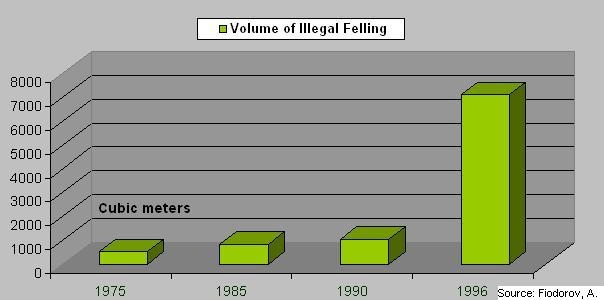
According to the official statistics generated by the Moldsilva State
Forestry Association, the total volume of registered illegal felling in the
forests managed by state forestry enterprises constituted 515 in 1975, 826
in
1985, 1,048 in 1990, and 7,096 cubic meters of wood in 1996. Probably, the
actual volume of illegal felling is much higher.[5]
 |
Dependent almost completely on unreliable
energy
supplies from Russia and Transnistria, a major energy crisis initiated
years of uncontrolled tree cutting (1992-1995) not only in the
forests,
but in nature reserves, floodplain forests, parks, and streets of
large
cities. Even vineyards and orchards have been cut down for fuel wood,
creating serious soil erosion. The overall increase in the volume of
unauthorized felling in Moldovan forests can be explained mainly by
the
inability of most villagers to pay for firewood needed for heating
purposes. There has been a steady upward trend in illegal felling
cases,
particularly during the last 12 years, post Transnistria-Moldova
conflict.[5] |
7. Type of Habitat: Temperate
Moldova's climate is moderately continental: the summers are warm and
long,
with temperatures averaging about 20°C, and the winters are relatively mild
and
dry, with January temperatures averaging -4°C. Annual rainfall, which ranges
from around 600 millimeters in the north to 400 millimeters in the south,
can
vary greatly; long dry spells are not unusual. The heaviest rainfall occurs
in
early summer and again in October; heavy showers and thunderstorms are
common.
Because of the irregular terrain, heavy summer rains often cause erosion and
river silting.
8. Act and Harm Sites: Moldova
Dispute Triggers in Transnistria-Moldova Conflict
Although having a distinctive national aspect, the Transnistria region
conflict can not be defined as solely an ethnic conflict. To the extent that
the
conflict surfaces in Western media, it is usually portrayed as a conflict
between an enclave inhabited by ethnic Russians and the largely ethnic
Romanian
Moldova. However, this is just not the case. The approximately 4,5 million
people in the Republic of Moldova, including Transnistria, consists of
approximately 60% Moldovans, 14% Ukrainians, and 13% Russians, as well as
other
smaller groups like the Christian Turkish Gagauz. This is not very different
in
Transnistria, where Moldovans make up 40%, Ukrainians 28% and Russians 23%
of a
population of 500,000. [23]
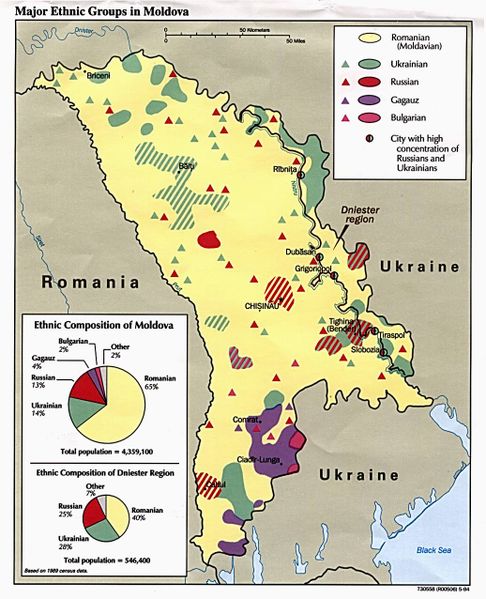 |
The causes of the conflict are complex, involving ethnic factors
and,
above all, maneuvering for power and wealth among elite groups.
Interethnic conflict in Moldova produced results similar to those
that
followed outbreaks of violence in other former republics of the Soviet
Union soon after they had proclaimed their independence. The
Transnistrian
“frozen conflict”, so-called because no progress has been made on
resolving the conflict in the past decade, mirrors other secessionist
conflicts in Georgia (Abhazia, Adjaria and South Ossetia) and
Azerbaijan
(Nagorno-Karabakh).
There are two main sources that feed the roots
of
these conflicts:
(1) Russia’s post-cold-war ambitions to retain
control over ex-republics through puppet regimes, and
(2) the huge
profits made from illicit drugs and human trafficking and smuggling of
arms from the ex-USSR military hardware depots.
The beneficiaries
of
such profits are the main advocates of the status quo in Transnistria,
Abhazia and South Ossetia. While attempting to gain a camouflaged
legalization of the secession, and eventually join these enclaves to
the
Russian Federation, the supporters of these regimes initiated a
“confederation” project that would in reality dismantle sovereign
countries like Georgia, Moldova, and Azerbaijan.[1]
Separatism movement was used with the aim of achieving
geopolitical
interests that usually harmonize with criminal ones. Transnistria has
become a hub for criminal activities, drug smuggling, and arms and
human
trafficking to Western Europe and the Middle East. [24]
The
international community treats political regime of Transnistria as
anti-democratic and authoritarian and considers Transnistria an outlaw
state governed by criminals. |
An appropriate background was necessary in order to
intensify tensions in the Transnistria-Moldova Conflict:
1. Creation of a permanently unstable zone (is a part of
the
methodology called the controlled chaos concept). It enables causing tension
on
a certain territory, thus, creating possibilities for influencing states and
international structures. The area of the region depends on the
geo-political,
geo-strategic, and geo-economic significance of the controlled region on the
one
hand, and on the cultural and information level typical for the region on
the
other.
2. Creation of serious obstacles in the
implementation of the concept of the unification of Romania and the
Bessarabian
and Transnistrian region. Any version of such a concept stipulates the
liquidation of the Russian military presence. Besides the de facto outdated
but
still important considerations of the military and strategic nature, the
loss of
control over the Bessarabian and Transnistrian region, in the eyes of the
considerable Russian military and political establishment, means a kind of
"official lowering of the flag" of Russia as a super-power in the so-called
Eurasian conception of this term followed by latter.
3. Creation of a territory that does not comply with the
internationally acknowledged norms and criteria, thus, allowing benefiting
from
certain economic advantages, and providing the possibility to carry out
different illegal special operations.[2]
Many analysts are convinced that a key factor obstructing a settlement is
the
personal interests of the leaders of Transnistria and Moldova, Russia and
Ukraine who profit from illegal activities that take place in Transnistria.
These activities include illicit arms sales, human trafficking of women and
girls and smuggling. Recently, a cache of 70 surface-to-air missile
launchers
disappeared from a former Soviet stockpile and officials are unable to
account
for their whereabouts. Moreover, there were reports that Russian troops in
Chechnya used illegally produced weapons in Transnistria.[12]
Figure 2: Conflict Triggers and Outcomes
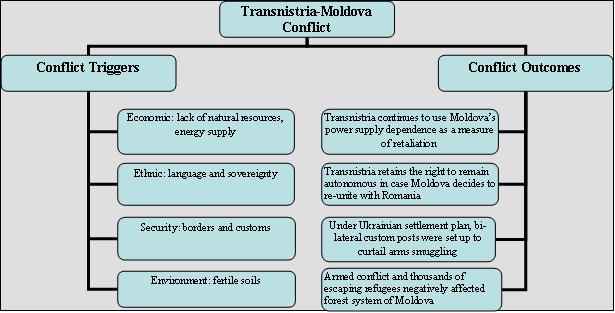
Economic triggers of the Transnistria-Moldova
conflict
The Republic of Moldova is a landlocked country with access to the Black
Sea
via the Dniester river and is situated between Romania and Ukraine. Harvard
Professor of Economics Dani Rodrik believes that geography has a significant
impact on a country's economic performance. Geography and lack of natural
resources can also be traced back to the roots of the Transnistria-Moldova
conflict. Despite, the country's chief assets of a mild climate and fertile
soils (1.7 million hectares of arable land in 1991), the economic growth is
stagnant, mainly because the economy is based solely on agriculture and
products
including vegetables, fruits, wine, grain, sugar beets, sunflower seed,
tobacco,
beef, and milk.
The country's lack of fuels and minerals significantly increases
Moldova's
trade deficit and makes the country heavily reliant on Russia for fuel
supplies.
This dependence intensifies Russia's key role in the Transnistria-Moldova
conflict. Russian energy subsidies to Transnistria, estimated to be worth
approximately $20 million annually, are almost the equivalent of the budget
of
the Transnistrian government. [23] The
dependence of
Moldova on energy supplies from Russia provides the latter with further
political leverage. In addition, some experts have expressed concern about
alleged Russian efforts to extend its hegemony over Moldova through
manipulation
of Moldova's relationship with its breakaway Transnistria region and energy
supplies. The strategic importance of Transnistria region to Moldova can
also be
attributed to the energy dependence of Moldova: 90% of power and 100% of
power
transformers are produced in Transnistria. Moreover, Transnistria's
authorities
have frequently disrupted the flow of fuels into Moldova from Russia and
Ukraine.[10]
Environmental triggers of the Transnistria-Moldova conflict:
Fertile Soils
Roughly three-fourths of the land area of Moldova or around 2.5 million
ha is
covered with chernozem (black earth, a variety of soil rich in organic
matter in
the form of humus) which is Moldova's main natural resource and the main
reason
for the agricultural orientation of the country's economy. No other country
in
the world has such a high share of chernozems. Throughout the long history
of
agricultural development on Moldovan lands, the natural process of soil
erosion
has been accelerated by improper agricultural practices and unsustainable
soil
management including inappropriate cultivation methods, the destruction of
original natural vegetation, clean cultivation, overgrazing, excessive
fertilization and irrigation and many others.
It has been estimated that at least 1,500,000 ha or around 59% of
Moldovan
agricultural lands are threatened with erosion. In some regions of the
country,
as much as 95% of agricultural land area can be eroded. At present, the area
of
eroded soil is over 850,000 ha, or one-third of agricultural lands,
including
two-thirds of arable land. More than 350,000 ha of agricultural land is
seriously affected by erosion, which resulted in the 40-60% loss of soil
productivity. The eroded area grows by 0.5-1% a year. The annual loss of
fertile
soil particles and humus amounts to about 20-25 million tons and 600,000
tons,
respectively. No doubt, soil erosion has long been recognized as a major
environmental problem in Moldova.[5] Considering the
facts of the fast rate of the soil erosion, the expansion of the fertile
soils
territory is vital to sustain the agricultural output and the fragile
economic
growth. In Transnistria, chernozems (fertile soils) occupy more than 90% of
the
total land area. Therefore, the fertile soils of the Transnistria region
represent strategic agricultutral interests of Moldova.
9. Type of Conflict: Civil War
10. Level of Conflict: Intrastate
The violence broke out in the fall of 1990. The Transnistrian "Republican
Guard" began to take over police stations, administrative bodies, schools,
radio
stations and newspapers. On December 13th, 1991 Moldovan police for the
first
time returned fire in defending the regional government building in
Dubossary.
The clashes renewed on March 1st, 1992. All efforts among Moldova, Russia,
Ukraine, and Romania to mediate the conflict failed. President Mircea Snegur
declared a state of emergency on March 28th, 1992. However, the conditions
took
a sharp turn to the worse in May of 1992 as the government made an effort to
disarm the paramilitary formations and escalated into a full-scale civil war
in
the city of Bendery on June 19th, 1992. After two days' fierce fighting, the
Moldovan units were driven out from the city. Moldovan President Mircea
Snegur
declared on June 22nd, 1992 that "we are at war with Russia".
On July 21st, 1992, an agreement was signed in Moscow between the
Republic of
Moldova and the Russian Federation on principles of a peaceful solution of
the
armed conflict in the Transnistrian region of Moldova. The agreement
provided
for an immediate ceasefire and the creation of a demilitarized security zone
between the parties, 10 km left and right of the Dniestr, including also the
city of Bendery. The trilateral peacekeeping troops (5 Russian, 3 Moldovan
and 2
Transnistrian battalions) began deployment on July 29th, 1992.
11. Fatality Level of Dispute (military and civilian fatalities)
Short but bloody conflict resulted in more than 700 deaths, 1,000 wounded
and
100,000 refugees. The detailed timeline of the events preceding the outbreak
of
combat actions can be further viewed
here.
12. Environment-Conflict Link and Dynamics:
Aside from ethnic, economic and security reasons, Transnistria-Moldova
conflict can be depicted in the following diagram:
Diagram 1: Environment-Conflict Link and Dynamics
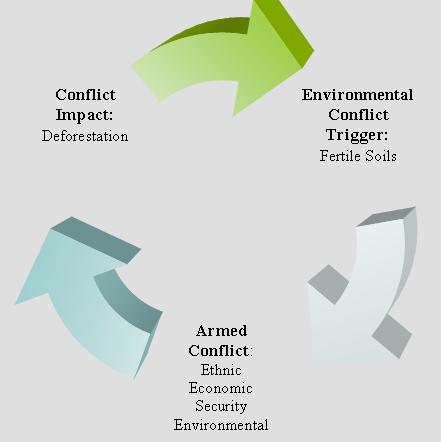
13. Level of Strategic Interest: State and Regional
For most of the duration of armed dispute in Transnistria, the level of
strategic interest was State and Regional. The conflict mostly concerned
separatist movement of Transnistria and the Moldovan government and army.
Today
the conflict borders on a multilateral level of strategic interest because
of
the conflict settlement involvement of Russia, Romania, Ukraine, EU, and the
US.
14. Outcome of Dispute: Stalemate
Despite the fact that on July 21st, 1992 a cease-fire agreement was
signed,
the Council of Europe recognizes Transnistria as a "frozen conflict"
region.
July 21st, 1992 agreement signed in Moscow between the Republic of
Moldova
and the Russian Federation provided for an immediate ceasefire and the
creation
of a demilitarized security zone between the parties, 10 km left and right
of
the Dniester River, including also the city of Bendery.
The agreement set out principles for a peaceful solution of the conflict,
including:
- Respect for the sovereignty and territorial integrity of Moldova
- The need for a special status of the left-bank Dniester region, and
- The right of the population of the left bank to decide on its own
future
if Moldova were to reunite with Romania.
Agreement also provided for trilateral peacekeeping forces, consisting of
5
Russian, 3 Moldovan and 2 Transnistrian battalions. However, this agreement
violates the international laws of peacekeeping. According to international
law,
peacekeeping forces must be composed of neutral forces. Despite this
inconsistency with international laws, the peacekeeping troops began
deployment
on July 29th, 1992. The cease-fire has largely been observed until the
present,
although numerous incidents in the security zone guarded by the trilateral
forces have been alleged by both sides.
Another proposal for reconciliation of the conflict is a so-called
Primakov
Plan (September, 2000). It called for the creation of a "common state" made
up
of "federative and confederative" ideas but weighed heavily toward
Transnistria's goals. Under this draft each side would be allowed to
maintain
its own constitution, legislative, executive, and judicial bodies, flag,
coat of
arms, and national anthem. Each would also have its own army, security
police,
and regular police that would not be able to operate on the other's
territory
without their consent. The common state would have jurisdiction over foreign
policy, economic policy, and border guards with no internal customs.
At first both sides strongly denounced the plan, with Moldova saying it
could
not agree to the country's "federalization" and Transnistria claiming that
any
rapprochement must be between virtually independent states.[16]
Recent
Developments:
In the summer of 2004, the Transnistrian authorities forcibly closed six
schools that taught Moldovan language using the Latin script. About 3,400
enrolled children were affected by this measure and the teachers and parents
who
opposed the closures were arrested. During the crisis, the Moldovan
government
decided to create a blockade that would isolate the autonomous republic from
the
rest of the country. The blockade was ineffective because of a lack of
cooperation from Ukraine's government. Transnistria retaliated by a series
of
actions meant to destabilize the economic situation in Moldova, in
particular,
by cutting the power supply from the power plants, which caused power
outages in
parts of Moldova.
Moldova's viewpoint of solution: departing from previous plan to include
Transnistria as a province of Moldova. Chisinau now proposes forming a
federation with Transnistria with conditionalities attached - retirement of
the
Russian army and demilitarization of Transnistria.
Transnistria now supports the idea of a federal state: two equal states
and a
common parliament formed by federative organs of power. Each state would
have
their own customs authority, army and departments dealing with licensing,
trade
and industry. This is one of the most important point of negotiation for
Transnistria, due to the fact that each time investors try to implement
economical activities in Transnistria they have to suffer a double tax
system,
paying for exports and license two times: one toTransnistria and another one
to
Moldova that do not recognize the authority of Transnistria. Transnistria
has
also suggested that the official languages should be Russian, Moldavian and
Ukrainian.
Ukraine proposed a seven-point plan in May of 2005 by which the
separation of
Transnistria and Moldova would be settled through a negotiated settlement
and
free elections. Under the plan, Transnistria would remain an autonomous
region
of Moldova.
Strategies to resolve the conflict:
Members of Moldovan civil society proposed 3D Strategy,
a
plan that provides specific policy recommendations for governments and
multilateral organizations, and provides citizens with the opportunity to
have
input in the future viability of their country. The plan calls for the
implementation of three principles:
Demilitarization-withdrawal of the Russian troops and
decommissioning of military plants and disarmament of the Transnistrian
military
and security forces;
Decriminalization-curbing and suppressing the rampant
contraband, arms and human trafficking, and other criminal activities;
Democratization-ensuring a free flow of information and
freedom of speech; implementing international human rights standards; and
promoting rule of law.
The success of this strategy will depend not only on the political will
of
the government of Moldova; it also needs the support and engagement of the
West-the EU, the OSCE and the United States-and Moldova’s neighbors-Ukraine,
Romania and Russia. All of these parties have a vested interest in ensuring
a
climate of regional security and stability.
The 3D Strategy outlines key
objectives to be met by 2012. They include expanding negotiation talks to
encompass the EU, the US and Romania, in addition to the current roster of
Russia, Ukraine, the OSCE, and Moldova, and removing negotiators from the
Transnistrian leadership. The plan also recommends establishing an
International
Executive Council that would monitor progress toward settling the conflict,
and
an International Civil Provisional Administration to help govern Moldova’s
eastern districts. In addition, the 3D Strategy calls for assigning Tiraspol
special status as a free economic zone with rights to self-government under
a
free-city model.[1]
15. Related ICE Cases associated with Territorial
Disputes:
Territorial dispute over rivers and water territory:
Conflict between Israel and Lebanon over the Litani River: LITANI
In 1980 war erupted between Iran and Iraq over control of the
Shatt-al-Arab
waterway: IRANIRAQ
Political conflicts between Egypt and Sudan over sharing of the Nile
waters:
NILE
and BLUENILE
Conflict between Karnataka and Tamil Nadu, both Southern Indian States,
over
Cauvery River for water supply: CAUVERY
The struggle for fresh water in the Middle East as a primary cause of the
1967 Arab-Israeli war: JORDAN
Territorial dispute over mineral
resources:
Conflict between Chad and Libya over uranium deposits: AOUZOU
The
territorial dispute between the former Soviet Union and China can be traced
back
to the 17th century which was triggered by rumors of fur, gold, and silver:
USSURI
Territorial dispute over oil resources:
The 1982 war over the Falkland/Malvinas Islands between Argentina and
Britain
over oil reserves within Islands' territorial waters: FALK
The
province of Aceh has a long tradition of resisting the Indonesian central
government in Jakarta. This resistance began as a religious movement, but
acquired a different tone once Mobil Oil Indonesia (MOI) discovered a vast
wealth of oil and natural gas deposits in Lhok Seumawe, North Aceh in 1971:
ACEH
Territorial dispute over land:
Armed dispites between the Peru and Ecuador for over one hundred and
fifty
years over The Cordillera del Condor: PERUEC
Conflict between El Salvador and Honduras over
lack
of land: SOCCER
Territorial dispute over culture, religion and ethnic
nationalism:
On April 10, 1998 Russia cut oil exports through Latvia in a dispute over
the
discrimination of the ethnic Russians in Latvia: LATVIAOIL
Territorial dispute between India and China for Arunachal Pradesh region
over
culture and religion: INDIA-CHNA
The civil war in the Sudan is routinely characterized as a conflict
between
Muslims and Christians, Arabs and Africans, or North and South. Religion,
ethnicity, economic and regional issues are the key triggers of the
conflict: SUDAN
Ethnic dispute in West Kalimantan between the Christian Dayaks and the
Moslem
Madurese. The conflict commenced mainly as a result of the Indonesian
Government's "transmigration plan." This program, which began in the 1930's,
moved people from the populated islands such as Java (Madura Island), to the
less populated islands of Irian Jaya and Kalimantan: KALIMAN
Territorial dispute between Azerbaijan and Armenia over Nagorno-Karabakh
region, located in Azerbaijan: NAGORNO
Territorial dispute between Georgia and Russia.
Ossetia's territory currently straddles the political divide between North
Ossetia-Alania in Russia, and South Ossetia in Georgia. The Ossetians
consider
themselves to be a separate ethnic group from either the Georgians or the
Russians: OSSETIA
Possible venues for further research of territorial
disputes:
Finnish Karelia, Petsamo, Salla, Kuusamo, some islands of Gulf of
Finland:
Russia and Finland (not governmental level debate)
Golan Heights: Syria
and
Israel (Shebaa Farms claimed by Lebanon and controlled by Israel)
Hans
Island: Canada and Denmark
Ivangorod: Russia and Estonia
Olivenza:
Spain
and Portugal
Pechorsky District of the Pskov Oblast: Russia and Estonia
Pedra Branca: Singapore and Malaysia
Pytalovsky District of the
Pskov
Oblast: Russia and Latvia
Sabah (North Borneo): Philippines and Malaysia
Snake Island: Ukraine and Romania
Tromelin: France and Mauritius
Vozrozhdeniya Island (see Aral Sea) : Kazakhstan and Uzbekistan
Black
Hills: United States government and the Lakota Nation
Northern Cyprus:
Republic of Cyprus and Turkish Republic of Northern Cyprus
Western
Armenia,
Van Province, Kars: Armenia and Turkey
For a complete listing of the
current
international disputes please consult CIA World Factbook
16. Relevant Websites and Literature
-
3D Plan to Address the Frozen Conflict in
Transnistria, Brussels, February 18th , 2005, http://foundation.moldova.org/pagini/eng/125 and http://www.moldova.org/pagini/eng/122/
-
Asarov, Boris, Kosovo versus Transnistria,
Moldova
Azi, Mar 13, 2006, http://www.azi.md/investigation?ID=38404
-
Commission of the European Communities, Commission Staff Working
Paper,
European Neighborhood Policy, Country Report: Moldova, Dec 5,
2004
-
Delgado, Talia, Transnistria, The Forgotten
Conflict, Apr 23, 2005
-
Fiodorov, Andrei , Facing Environmental Problems: the
Case of the Republic of Moldova, Journal of Eurasian Research, http://www.actr.org/JER/issue6/7.htm
-
Goodhand, Jonathan, Conflict Assessments, A Synthesis
Report: Kyrgyzstan, Moldova, Nepal and Sri Lanka, Centre for Defense
Studies King's College, University of London
-
Hagmann, Tobias, Confronting the Concept of Environmentally Induced
Conflict, Peace, Conflict and Development, Issue Six, January
2005
-
http://encyclopedia.thefreedictionary.com/Transnistria
-
http://en.wikipedia.org/wiki/Transnistria
-
http://www.photius.com/countries/moldova/economy/moldova_economy_energy_and_fuels.html
-
Iovu, Tudor, http://www.foto.md/persgal.php?gid=13&action=showphotos&puid=4
-
ITAR-TASS, Trans-Dniester Region Denies Exporting
Weapons to Chechnya, Feb 1, 2001
-
LEAD, The Sustainability of Societies in Transition: Agrarian
Reform
and Sustainable Agriculture in Moldova, December, 2004
-
Nantoi, Oazu, The Frozen Conflict in Transnistria: Presentation in
Washington, Institute of Public Policies, Jan 14, 2005
-
National Human Development Report - 1996, State Building and
Integration of Society, Republic of Moldova
-
Quinlan, Paul D, Moldova under Lucinschi,
Demokratizatsiya, Winter 2002, http://www.findarticles.com/p/articles/mi_qa3996/is_200201/ai_n9062110/pg_5
-
Ross, Michael, Natural Resources and Civil War: An Overview with
Some
Policy Options, Dec 13, 2002
-
Skordas, Achilles, Transnistria: Another Domino on Russia's
Periphery?, Yale Journal of International Affairs, Summer/Fall
2005
-
Spanu, Vlad, Why is Moldova Poor and Economically Volatile?,
Dec
21, 2004, http://foundation.moldova.org/pagini/eng/822/
-
The Economist Print Edition, The Hazards of a Long, Hard
Freeze,
Aug 19, 2004
-
Transdniestrian Conflict, Origins and Main Issues, Based on the
Background Paper "The Transdniestrian Conflict in Moldova: Origins and
Main
Issues", CSCE Conflict Prevention Centre, Vienna, June 10, 1994, http://www.state.gov/documents/organization/13611.pdf
-
Transnistria, The Forgotten Conflict, http://www.brain-storming.info/article.php?ida=70
-
Vahl, Marius, Borderland Europe(11): Transforming
Transnistria?, Jan 9, 2005
- Woehrel, Steven, CRS Report for Congress, Moldova:
Background and U.S. Policy, Updated March 8, 2005
- www.kross.ro/transdniestria_map
For use of this background, please link to GRSites
Feel free to contact me with
your
questions or recommendations.
Wednesday April
12,
2006 4:30 PM











